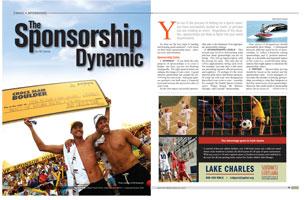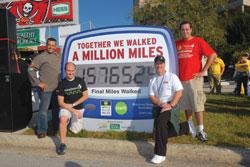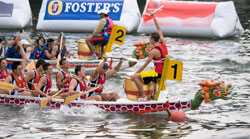
You are in the process of bidding for a sports event, you have successfully landed an event, or perhaps you are creating an event. Regardless of the situation, sponsorships are likely to factor into your event requirements.
So what are the key steps to landing and keeping good sponsors? Let's focus on three basic sponsorship areas -sales, services, and retention.
Sponsorship Sales 1. Strategy - If you think the only purpose of sponsorships is to cover a budget line item, you are not thinking strategically. The right sponsor brand can enhance the image of your event. A good sponsor partnership can expand the advertising for your event. And great sponsor products can both meet a financial need and increase the perceived value of your event.
1. Strategy - If you think the only purpose of sponsorships is to cover a budget line item, you are not thinking strategically. The right sponsor brand can enhance the image of your event. A good sponsor partnership can expand the advertising for your event. And great sponsor products can both meet a financial need and increase the perceived value of your event.
So the first step to successful sponsorship sales is development of an appropriate sponsorship strategy.
2. Sponsorships Levels - This second step involves determining what and how many sponsorships you are offering. This will go hand-in-glove with the pricing for each. This step also involves appropriately titling each level. For example, you may have a title sponsor, presenting sponsor, official sponsors, and suppliers. Or perhaps it's the tried-and-true gold, silver, and bronze sponsors. Or come up with your own designations that reflect your event or area - consider, for example, the Seattle Sports Commission's “Puget Sound, Mt. Rainier, Olympic, and Cascade” sponsorships.
Your choice of designations should accomplish three things: 1) distinguish between different types/levels of sponsorships, 2) reflect a hierarchy among sponsorships, and 3) position sponsorships as a desirable and important aspect of the event (i.e. avoid frivolous designations that might appear to diminish the sponsorship value).
3. Pricing - Sponsorship pricing should be based on the market and the sponsorship value. Event managers often make the mistake of pricing sponsorships according to what they budgeted or feel they must receive from sponsorships. However, this could result in sponsorship prices far in excess of what companies are used to paying in the market or for that type of event, leading to sponsorship sales falling short of goal. In the alternative, significantly underpricing sponsorships could create concern among prospects as to whether the event actually has value.
Before determining a price structure it is best to research the marketplace (local, state, regional, or national) from which you intend to solicit sponsors. Research should also be done on sponsorship pricing for similar events.
4. Benefits - Benefits make up a significant amount of the sponsorship value referred to in our pricing discussion.
 In the sports marketplace a large number of organizations that serve as event hosts, as well as event right holders, are non-profit corporations. Used to dealing on a daily basis in the non-profit world, they often forget that a sponsorship is not a contribution. That means that a company purchasing a sponsorship is expecting something in return. This return on their investment is often referred to as sponsorship ROI.
In the sports marketplace a large number of organizations that serve as event hosts, as well as event right holders, are non-profit corporations. Used to dealing on a daily basis in the non-profit world, they often forget that a sponsorship is not a contribution. That means that a company purchasing a sponsorship is expecting something in return. This return on their investment is often referred to as sponsorship ROI.
To create sponsorship value or ROI, you have to provide sponsorship benefits that are tiered to provide more or more valuable benefits to the higher level sponsors.
I suggest creating a sponsorship chart or matrix that reflects the different sponsorship designations, benefits, pricing and lengths of term. This internal document helps provide an overview as well as detailed understanding of the differentiation between sponsorships. You should feel totally comfortable with the matrix before making any sponsor presentations.
5. Research - While research does not seem that exciting, it is perhaps the most important step in the process. After all, there is no sense in wasting time pursuing a company that doesn't do sponsorships or only sponsors arts and culture.
If the event is local in nature, you should begin by researching companies that sponsor sports events in your market. Once you have identified a list, determine which among those has done sponsorships at the financial level you are seeking. This may shorten your list.
 Of that group, research what is important to each company in terms of sponsorships. Some may even include such information on their websites.
Of that group, research what is important to each company in terms of sponsorships. Some may even include such information on their websites.
Research current activities for each corporation on your short list. Is there a new product launch upcoming? Is there a re-branding or new branding campaign in the works? Is the company growing dramatically in terms of employees and revenues? Such “current events” can factor directly into a match for your event and at the very least can be a strong conversational hook that reflects the fact you did your homework before approaching the prospect.
6. Presentation - The sponsor pitch should be made to the sponsorship manager, marketing director, community relations specialist, or even the CEO if possible. Your goal is to start with a sponsorship decision-maker. The pitch might include well-organized PowerPoint presentations on the event and why the prospect would benefit from sponsoring it. A brief video can be a great touch. And a comprehensive packet of information including a handout with details of the sponsorship requested and the specific benefits that go with it should be provided as a leave-behind.
7. Follow-up - Thank you notes or emails sent out immediately, and timely follow-up on all questions asked in the presentation or subsequent to the presentation, are essential to demonstrate your sponsor servicing capabilities and desire to strike a partnership.
Sponsor Services Once a sponsorship is secured, the keys to sponsor happiness are 1) delivering all the benefits promised in a time frame that allows the sponsor to take full advantage of them, 2) being constantly available to take sponsor questions and handle sponsor needs - i.e. demonstrating superior sponsor or customer service, and 3) going above and beyond the expected (i.e. over delivering) with more benefits, service, or both.
Once a sponsorship is secured, the keys to sponsor happiness are 1) delivering all the benefits promised in a time frame that allows the sponsor to take full advantage of them, 2) being constantly available to take sponsor questions and handle sponsor needs - i.e. demonstrating superior sponsor or customer service, and 3) going above and beyond the expected (i.e. over delivering) with more benefits, service, or both.
Sponsor Retention
It is generally easier to keep a current sponsor than to secure a new one. To help drive longer term relationships with sponsors - i.e. to multiple events, not just one - provide the sponsor with 1) a summary after - action report on the event indicating strong areas and weak points with a plan for improving the weak ones (select participant comments could be beneficial here), and 2) a report - including renderings and/or photos where appropriate - documenting the benefits they received.
 If you have a good event and you have done your homework, targeted well, made a nice pitch, and followed-up appropriately, you are likely to land the sponsor you need at or near the pricing and term you desire. Keep in mind that the best sponsorships are true partnerships, and if you solidify the relationship with superior customer service and after-event documentation, the future should be bright for a long-term sponsor relationship.
If you have a good event and you have done your homework, targeted well, made a nice pitch, and followed-up appropriately, you are likely to land the sponsor you need at or near the pricing and term you desire. Keep in mind that the best sponsorships are true partnerships, and if you solidify the relationship with superior customer service and after-event documentation, the future should be bright for a long-term sponsor relationship.

